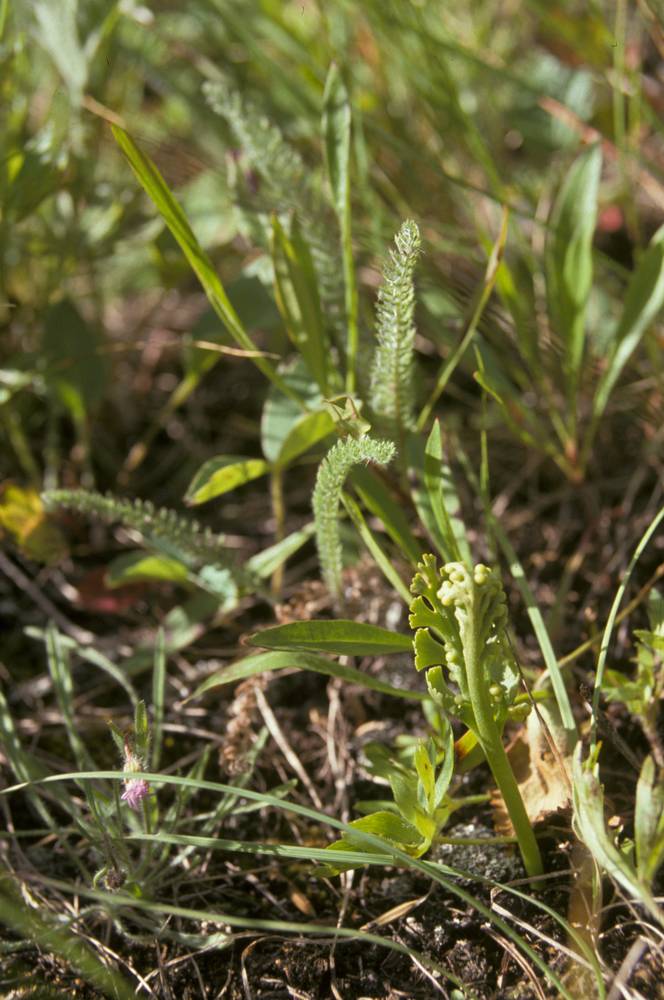Botrychium ascendens
Botrychium montanum
upswept moonwort
mountain moonwort, western goblin
(40)44–47(54) μm.
54(47–57) μm.
well developed; greater than 2 cm, green.
well developed; greater than 2 cm except in very small plants, green.
sessile or short-stalked; the stalk occasionally to 2 cm long;
blade 1-pinnate, narrowly oblong-triangular; to 6 × 2 cm, yellow-green and shiny in life;
pinnae to 6 pairs, strongly ascending, narrowly fan-shaped, spanning an arc of less than 90°; broadest at the outer margin, usually coarsely toothed and with 2–5 lobes; lower pinnae often bearing marginal sporangia.
with stalk 0.3–2 cm long, usually comprising 25–50% or more the total trophophore length;
blade 1-pinnate, oblong to linear; to 4 × 1 cm; dull green, glaucous, often appearing fleshy;
pinnae to 3(5) pairs, often irregularly spaced with adjacent pinnae often confluent, sometimes completely fused to form a spoon-shaped blade, spreading to ascending; wedge-shaped with nearly parallel sides and a truncate or slightly rounded, often lacerate outer margin.
stiffly erect;
stalk 0.5–1 times as long as the trophophore at spore release, rarely longer;
branches mostly simple, strongly ascending.
stiffly erect;
stalk (0.5)1–3 times as long as the trophophore at spore release;
branches much reduced, often appearing absent.
=180 (allotetraploid, apparently derived from B. crenulatum and B. lineare).
=90.
Botrychium ascendens
Botrychium montanum
Open, well-drained areas and historically disturbed sites with a sparse to dense cover of grasses, forbs, and small shrubs or conifer saplings, such as montane or subalpine meadows, avalanche meadows, road shoulders, ski areas, and mining disturbances. 1500–2000 m. BW. CA, ID, NV, WA; scattered in western and northeastern North America. Native.
Botrychium ascendens is easily confused with B. crenulatum, B. lineare, and B. minganense.
Moist duff around seeps or streams under mature Thuja plicata or, rarely, Picea engelmannii, at mid-montane elevations. Occasional in fen-like seeps or in moist to wet meadows with moss or lush herbaceous cover at subalpine elevations. 900– 2500 m. BW, Casc, ECas. CA, ID, WA; north to AK, northeast to MT. Native.
Botrychium montanum is our smallest moonwort.
Ben Legler
Ben Legler
- Local floras:
BC,
CA,
OR,
WA
- Local Web sites:
CalFlora,
CalPhotos,
Flora NW,
PNW Herbaria
WildflowerSearch
iNaturalist (observations)
USDA Plants Database
- LBJ Wildflower Center
- SEINet
- Plants of the World Online
- Encyclopedia of Life
- Wikipedia
- Google Image Search
- Local floras:
BC,
CA,
OR,
WA
- Local Web sites:
CalFlora,
CalPhotos,
Flora NW,
PNW Herbaria
WildflowerSearch
iNaturalist (observations)
USDA Plants Database
- LBJ Wildflower Center
- SEINet
- Plants of the World Online
- Encyclopedia of Life
- Wikipedia
- Google Image Search





